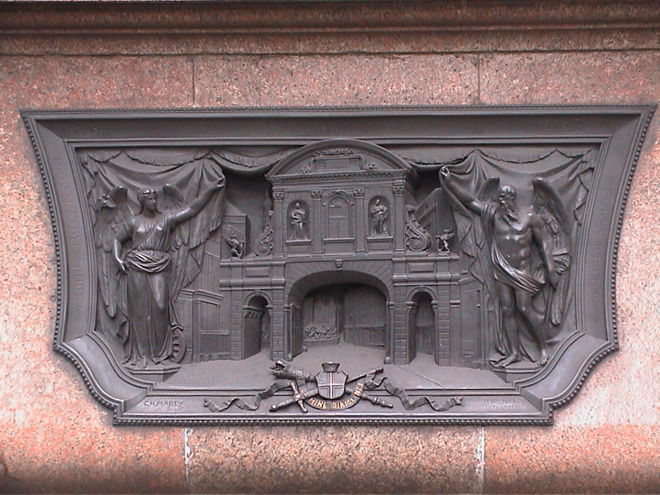Erection date: 1881
{On the frieze at the top of the monument, above the columns, text runs around the whole monument, reading:}
Temple Bar formerly stood here. MDCCCLXXX {=1880}
{On the east face there is a bronze relief showing the Temple Bar about to be hidden behind curtains being drawn by an angel on each side (representing Time and Fortune). Around the frame:}
Temple Bar. Erected 1672 by Sir C Wren arch. Removed 1878. This memorial erected 1880 by Horace Jones Arch. V.P.RIBA
{Signed:}
C. H. Mabey. Sculpt.
{On the west face there is a heavily decorated bronze cartouche:}
This memorial of Temple Bar was erected during the mayoralty of the Right Honourable Sir Francis Wyatt Truscott Knt. Under the direction of the Committee for letting the City Lands of the Corporation of London, John Thomas Bedford Esq., Chairman. The west side of the plinth is coincident with the west side of Temple Bar and the centre line from west to east through the gateway thereof was 3 feet 10 inches southward of the Broad Arrow here marked.
Messrs John Mowlem & Co - contractors
Horace Jones V P RIBA - architect to the Corporation of London.
{Signed:}
C. H. Mabey. Sculpt.
Site: Temple Bar memorial (9 memorials)
EC4, Fleet Street
This is the site of the 17th century Temple Bar entrance to the City of London. Having become an obstruction to circulation it was removed in 1879 and this monument unveiled in 1881, as a memorial to the old Temple Bar and as a marker for the entrance to the City at the point where it was traditional for the Lord Mayor to welcome royal visitors to the City.
This is a typically overwrought late Victorian edifice, topped with a giant griffin (or dragon; there are competing definitions of the differences) by Charles Birch. The north and south sides hold large statues of Queen Victoria and, the soon to be, Edward VII. To east and west are medallion portraits of the Lord Mayor at the time, Sir Francis Wyatt Truscott, and Prince Albert Victor, the King we never had. At the bottom of the west face gilt lettering carved into the granite base announces "City of London".
Each side holds a bronze relief plaque, one of which states that the monument is aligned exactly with the west side the old Temple Bar and specifies the north-south displacement - a good example of Victorian flamboyance married to technical confidence. A carved pillar is placed at each corner, decorated with symbols for arts, science, peace and war. Arts includes two busts: to the north Homer and to the south Chaucer.
We have treated many of these features as separate memorials and give more details of each one on its own page. Ornamental Passions has a very good post on this edifice.



















Comments are provided by Facebook, please ensure you are signed in here to see them